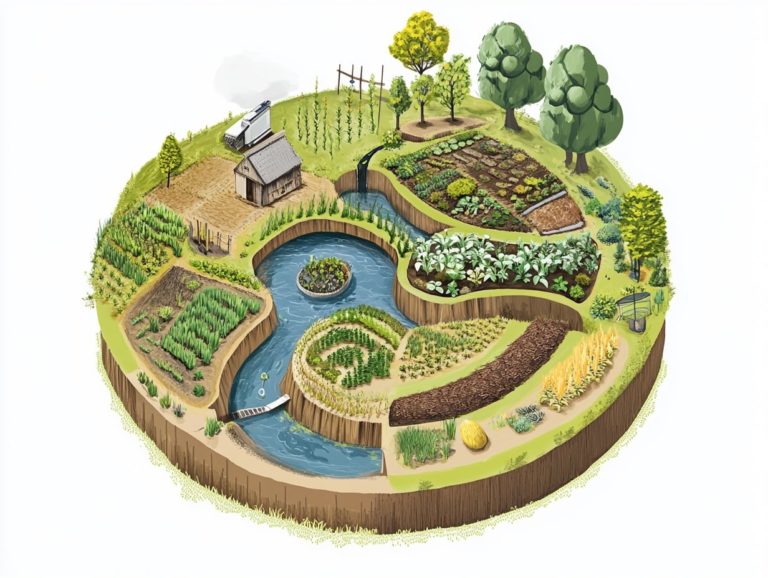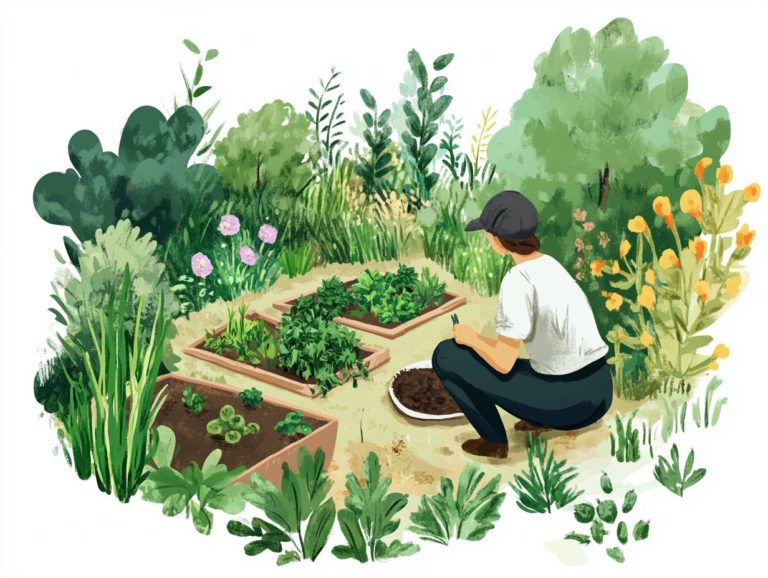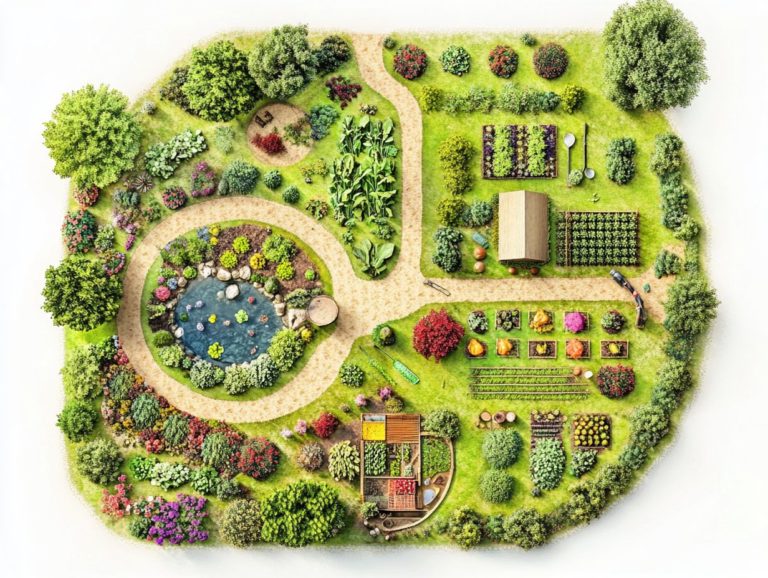Designing for Social Permaculture
Social permaculture presents a transformative opportunity for you to build resilient communities by weaving together ecological principles and social equity.
This exploration delves into the essence of social permaculture, beginning with a clear definition and its foundational values. You ll uncover essential design strategies, witness real-world examples, and appreciate the tangible benefits that emerge for both individuals and communities.
The discussion also addresses common challenges you might face, offering practical solutions for successful implementation. Discover how embracing social permaculture can pave the way for a more sustainable and interconnected world, enriching the lives of all involved.
Contents
- Key Takeaways:
- Understanding Social Permaculture
- Principles of Social Permaculture
- Designing for Social Permaculture
- Implementing Social Permaculture in Communities
- Benefits of Social Permaculture
- Challenges and Solutions
- Frequently Asked Questions
- What is social permaculture?
- How does designing for social permaculture differ from traditional design?
- What are the benefits of designing for social permaculture?
- What are some key principles of designing for social permaculture?
- How can I apply social permaculture principles to my own community or organization?
- What are some examples of successful social permaculture design projects?
Key Takeaways:
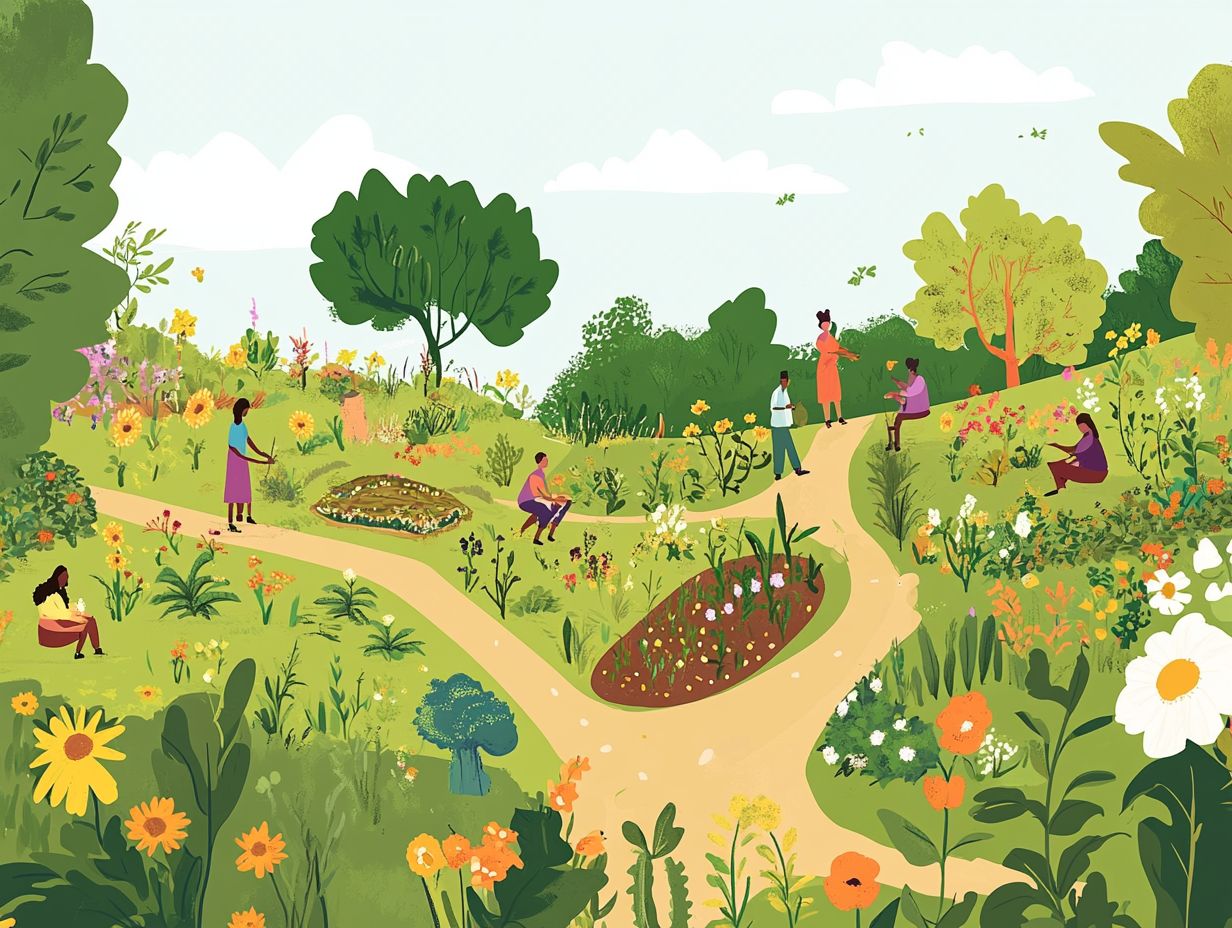
- Social permaculture is a design approach that integrates ethical principles and values to create sustainable and resilient communities.
- The key considerations and strategies for designing for social permaculture include understanding community needs, promoting inclusivity, and building strong relationships based on trust and mutual support.
- Implementing social permaculture can bring both individual and community benefits, such as increased self-sufficiency, improved social connections, and a more harmonious relationship with nature.
Understanding Social Permaculture
Understanding Social Permaculture requires you to grasp the important ideas of ecological design, which is a way of creating systems that work with nature. This approach nurtures community building, champions environmental justice, and embraces diversity, much like the principles found in designing with perennials in permaculture.
By adopting this holistic perspective, you can address the social fabric of your community while fostering intentional communities groups that come together intentionally to achieve common goals. Implementing these principles allows you and your group to cultivate beneficial relationships and create interconnected systems that enhance soil health and bolster community resilience.
Defining the Concept
Defining Social Permaculture requires you to grasp how ecological design principles can be seamlessly integrated into social systems. Understanding the key elements of successful permaculture design emphasizes the interconnectedness of relationships and the vital role of empathy and healing within communities.
Unlike traditional permaculture, which primarily focuses on agricultural practices, Social Permaculture intricately weaves together the elements of human interaction, cooperation, and shared resources to cultivate resilience and mutual support. This approach recognizes that social dynamics mirror natural ecosystems, where each individual plays a crucial role in maintaining harmony and balance, as highlighted in the interconnectedness of permaculture design elements.
By applying systems theory, you can create structured environments that promote dialogue and inclusivity, effectively addressing challenges such as conflict resolution and community bonding. Initiatives like community gardens do more than just provide food; they serve as vibrant spaces for communal gatherings, nurturing relationships and fostering understanding among diverse groups.
These implementations underscore the immense potential of Social Permaculture not only to cultivate sustainable practices but also to foster thriving communities that understand permaculture design principles and empathy.
Principles of Social Permaculture
The principles of Social Permaculture provide you with a guiding framework that emphasizes essential values like community development, collective action, and the benefits of collaborative permaculture design.
This approach builds an ethical framework to construct non-hierarchical structures, empowering both individuals and groups in the process.
Start your journey towards a resilient community today! Join us in building a future where social permaculture thrives, and everyone benefits.
In summary, social permaculture is not just a method; it s a movement. Embracing its principles can lead to a more sustainable and equitable world. Explore further and get involved!
Core Values and Ethics
The core values and ethics of Social Permaculture center on environmental stewardship, community engagement, and shared responsibility. These principles inspire transformative practices within your community.
These concepts emphasize earth care, people care, and fair share. They significantly influence social interactions and guide how you work together on sustainability projects.
For instance, in a community garden initiative, participants embody earth care by using organic farming methods. These methods enhance soil quality and biodiversity.
This approach yields fresh produce and fosters connections among neighbors. They come together regularly to share knowledge and celebrate their harvests.
Ensure everyone has access to resources. This embodies the fair share principle, allowing all community members, regardless of their background, to benefit from shared efforts.
Designing for Social Permaculture
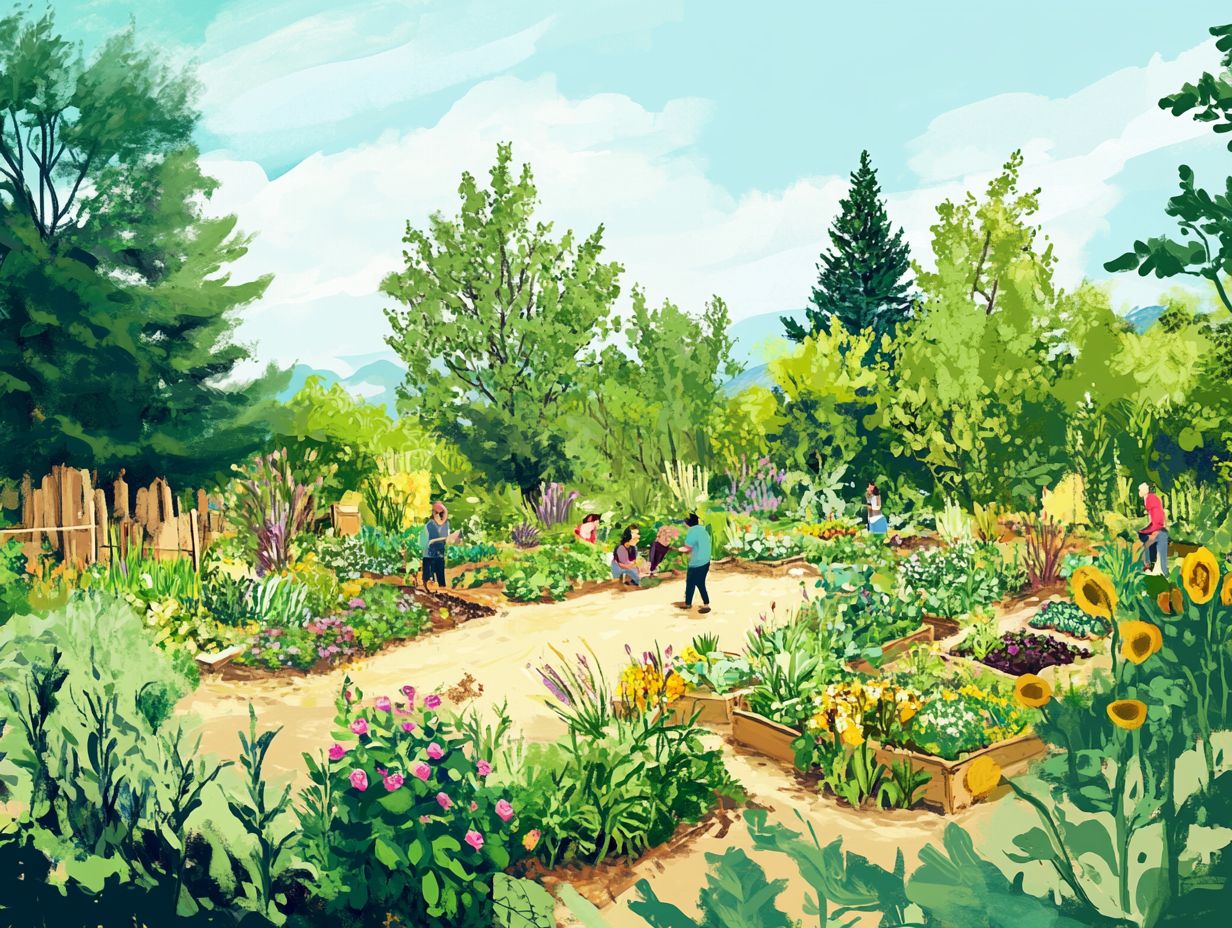
When you design for Social Permaculture, you embrace a blend of ecological design principles and a step-by-step method. This integration allows you to create innovative solutions for social challenges while enhancing urban planning that promotes sustainable living, highlighting the role of community in permaculture design.
Key Considerations and Strategies
Key strategies in Social Permaculture emphasize active engagement, understanding group dynamics, and using effective conflict resolution methods. These are vital for fostering healthy community interactions.
These components create a vibrant ecosystem within community networks, where individuals feel empowered to share ideas. Explore strategies like collaborative decision-making and participatory workshops to appreciate how to engage members effectively.
Successful case studies show how facilitated discussions can ease tensions. These techniques acknowledge diverse perspectives while promoting consensus.
Understanding group dynamics through regular reflections and feedback mechanisms enhances relationships among participants. This ensures sustainable engagement and a harmonious atmosphere.
Implementing Social Permaculture in Communities
Implementing Social Permaculture in your community requires a participatory decision-making process. This fosters co-creation and encourages active engagement among residents.
Explore various case studies to witness the transformative impacts of this collaborative approach.
Examples and Case Studies
Examples and case studies of Social Permaculture highlight successful community-building initiatives. These champion environmental sustainability and drive transformational change in diverse contexts.
One rural community in Australia embraced a social permaculture framework to rejuvenate their ecosystem and strengthen bonds among neighbors. They enhanced biodiversity through engaging workshops and collaborative garden projects.
An urban initiative in Canada showcased how thoughtfully designed food forests can convert vacant lots into vibrant community hubs. These spaces serve as both food sources and gathering areas, merging social care with ecological design for extraordinary benefits.
Benefits of Social Permaculture
Social Permaculture offers incredible benefits that strengthen our communities. It promotes a sense of collective responsibility and allows you to nurture vibrant, healthy social ecosystems while understanding the Permaculture design process.
Individual and Community Impacts
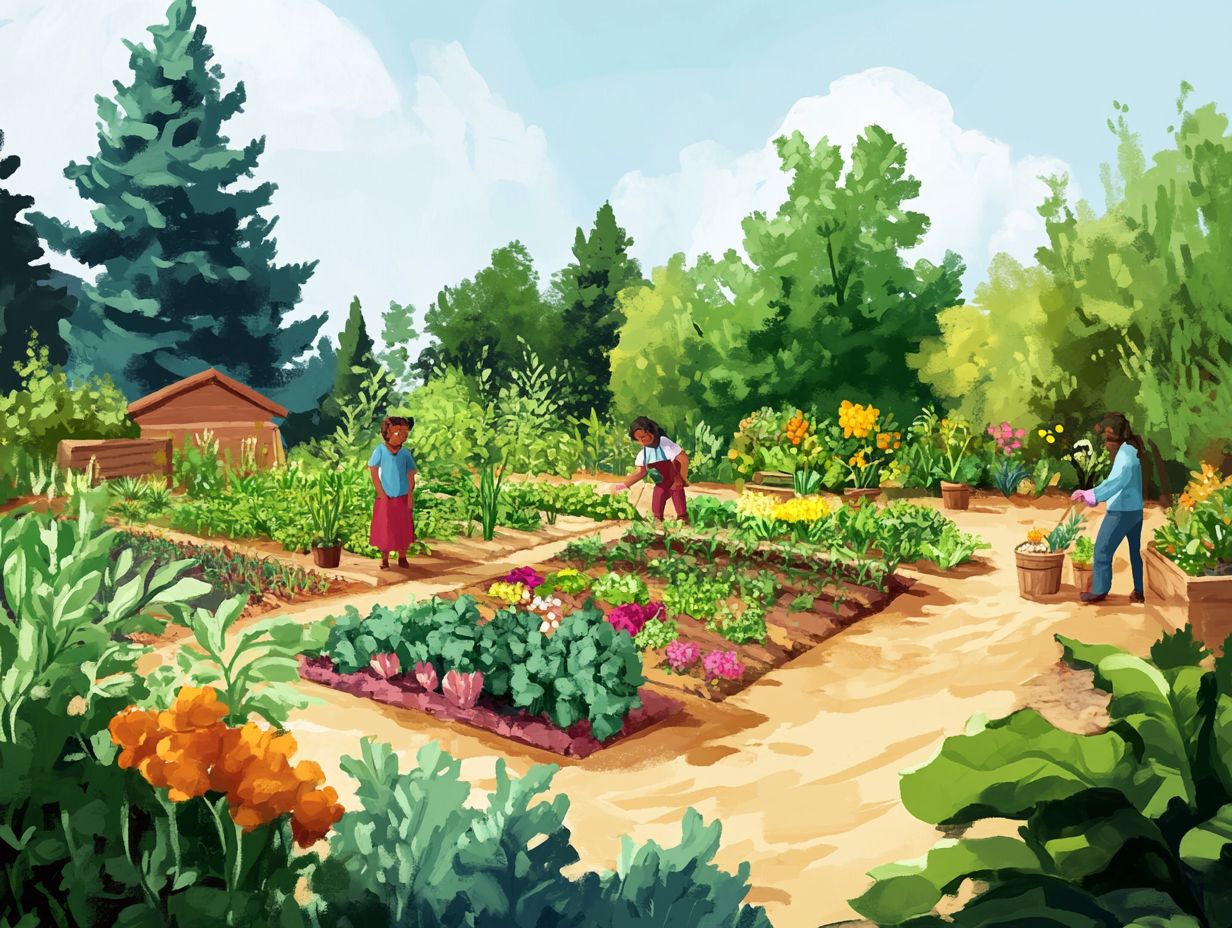
The individual and community impacts of Social Permaculture unfold through personal growth and the reinforcement of shared values. This results in enriched social interactions and enhanced community resilience.
By prioritizing collaboration and ecological stewardship, this approach cultivates a profound sense of belonging among participants. You may experience transformative moments where you acquire practical skills and forge deeper connections with those around you.
Consider a local group involved in a permaculture initiative that proudly shares success stories about establishing a neighborhood garden. This garden has become more than just a food source; it has evolved into a vibrant hub for learning, sharing, and support.
These efforts inspire you to take action for your community! They demonstrate how collective efforts can significantly bolster social cohesion and pave the way for a more sustainable future.
Challenges and Solutions
In the realm of Social Permaculture, you will often face challenges that center around dealing with complex relationships and understanding how people in groups interact. Effectively implementing conflict resolution strategies is essential for fostering cohesiveness within the community.
Engaging with these complexities enhances your understanding and gives you the power to create harmonious and sustainable social environments.
Overcoming Obstacles to Implementation
Overcoming obstacles to implementing Social Permaculture demands innovative approaches and creative solutions. These strategies elevate community engagement and foster resilience.
Challenges can vary significantly, ranging from limited resources and funding to a general lack of awareness among community members regarding the benefits of sustainable practices.
For instance, establishing local workshops and training sessions educates participants about social permaculture principles and immerses them in hands-on projects.
By forming small, interactive groups, community members can exchange experiences and skills. This fosters a sense of ownership and collective responsibility, nurturing understanding and transforming resistance into genuine enthusiasm. It empowers the community to embrace sustainability as a shared endeavor.
Frequently Asked Questions
Social permaculture is the application of permaculture principles to design and create sustainable and regenerative social systems and communities, including how to explore the role of design in permaculture success.

Traditional design focuses mainly on creating physical structures and spaces. In contrast, understanding permaculture design for sustainability considers human relationships, communication, and community building as essential design elements.
Designing for social permaculture leads to more resilient and self-sufficient communities. It improves communication and relationships, highlighting the power of community in permaculture design and creating a greater sense of connection and belonging among community members.
Key principles include observing and understanding existing social systems, designing for diversity and inclusion, promoting cooperation and collaboration, and considering the long-term impacts of design decisions on both people and the environment.
You can start by observing and understanding the current social dynamics and systems in place. Identify areas for improvement and involve community members in the design process to ensure their needs and perspectives are considered.
Don t wait! Find resources and workshops on social permaculture to deepen your understanding and skills.
Successful social permaculture projects include community gardens, urban farms, and planned communities. These initiatives focus on sustainability, using eco-friendly farming practices that restore soil health.
They also aim to build supportive communities where everyone can thrive together.

